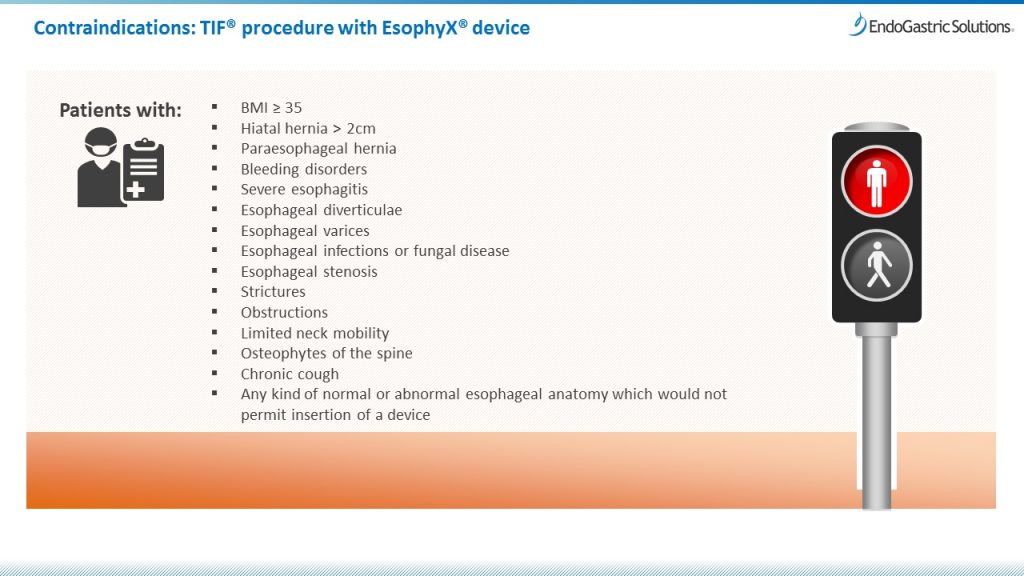Following is a summary of safety information related to the TIF procedure to help you better understand any potential risks that might arise.
Risks of the TIF Procedure
While the TIF procedure with the EsophyX device is less invasive than conventional laparoscopic antireflux surgery and has an excellent safety profile, it is important to note that it is still a surgical procedure. The TIF procedure is a variation of laparoscopic Nissen fundoplication, which is a surgical procedure designed to treat gastroesophageal reflux disease (GERD) and severe acid reflux.
All procedures have risks, and you should always understand the risks associated with any procedure before deciding to undergo surgery. Speak to your physician in detail about the risks and complications that may arise before committing to the TIF procedure or any surgical solution.
Typical known risks or discomforts from endoscopic procedure may include:
Temporary dysphagia (difficulty swallowing) or odynophagia (painful swallowing), due to swelling or tissue manipulation, hoarseness, gagging, globus pharyngis, inflammation reaction from lubricant, or other temporary pain which responds to standard pain medication.
These side-effects are relatively common for any endoscopic procedure and occur in slightly more than 25% of patients who undergo the TIF procedure. They are usually mild in severity and resolve themselves shortly after surgery.
Unusual risks or discomforts as a result of an endoscopic procedure:
Injury of mouth and/or teeth, bite block related injury, persistent odynophagia or dysphagia requiring intervention, bleeding, perforation, abrasion, hematoma/edema, laceration, esophageal tear, gas bloat, dyspepsia, diarrhea, infection, fistulae between inner organs, vomiting, nose bleeding from nasal intubation, vocal cord nodules due to intubation, hiccups, and limited neck mobility.
These infrequent side effects occur in 1-10% of patients who have the TIF procedure, and they are also common with any endoscopic procedure. They are usually mild in severity.
Rare risks as a result of an endoscopic procedure and of this particular procedure:
Lockjaw, aspiration, hypoxia, achalasia, nerve damage, focal necrosis, tissue damage, ulceration/abscess, gastrointestinal and pancreatic leaks, pancreatitis, acute abdomen, peritonitis, bowel obstruction, pericardial effusion, capture of other inner organs which may neighbor the suturing site or resulting from adhesions from previous abdominal infections or surgical procedures, potentially resulting in fistulae between inner organs or the inner organs and the abdominal or thoracic cavity, pneumothorax, thoracic, mediastinal, or abdominal abscess, mediastinitis, pneumoabdomen, bleeding requiring blood transfusion, surgery for uncontrolled bleeding and/or perforation, chest pain, cardiac event, ulcer, medical or surgical treatment as a result of the occurrence of complication, procedure related failure requiring medical intervention or surgical conversion, embolism, death.
These side-effects can be associated with any endoscopic procedure and occur in less than 0.5% of those who have the TIF procedure. Rarely, additional surgery may be needed to repair an adverse event from the first procedure.
Additional risks may include:
- Additional surgery after a failed procedure (e.g., if there is insufficient symptom relief)
- Moving and fastening of tissue other than gastric tissue
TIF Procedure is Revisable
It is important to remember that GERD is a chronic disease that requires a lifetime of management to control symptoms. As with laparoscopic procedures, in a minority of patients, additional surgery is sometimes desired for more adequate symptom relief. In a study published in 2014, 28 patients who were previously treated transorally underwent a subsequent laparoscopic Nissen fundoplication safely and effectively.
Indications for TIF Surgery
The TIF procedure, using the EsophyX device, may be right for you if:
- You are at least 18 years old
- You regularly experience troublesome symptoms of symptomatic chronic GERD
- You no longer respond adequately to, or are dissatisfied with, antireflux medicines
- You are concerned about the adverse long-term effects of taking proton pump inhibitors and other medicines
- You have a hiatal hernia no larger than 2 cm in size or can have a hiatal hernia repair immediately prior to the TIF procedure
- You have a Body Mass Index (BMI) less than 35
Your physician may have other criteria he or she uses to determine whether you are an appropriate candidate. Ask your physician to discuss those criteria with you.
Contraindications for TIF procedure
The TIF procedure may not be right for you if:
- You are under 18 years old
- Your BMI is greater than 35
- You have a hiatal hernia greater than 2cm that can’t be repaired just prior to the TIF procedure
- Paraesophageal hiatal hernia
- You have suffered from any of the following esophageal-related concerns:
- severe inflammation of the esophagus
- abnormal, enlarged veins in the lower part of the esophagus (varices)
- infections or fungal disease in the esophagus
- unusually narrow diameter of the inside of the esophagus
- sacs or pouches (diverticula) in the wall of the esophagus
- narrowing of the esophagus
- an obstruction or hernia next to the esophagus
- You have suffered from any of the following health concerns:
- bleeding disorder
- chronic cough (not related to GERD)
- limited neck mobility
- bone spurs in the spine
- The anatomy of your esophagus would prohibit insertion of the EsophyX device
- You are unable to comply with post-operative diet recommended for appropriate healing
Your physician may have other criteria he or she uses to determine whether you are an appropriate candidate for the TIF procedure. Ask your physician to discuss the criteria, as well as any other safety concerns, with you.
You can find regulatory and labeling information here.
https://www.gerdhelp.com/wp-content/uploads/2018/08/36-Contraindications-1024×576.jpg
References:
1. Bell RC, et al; Surg Endosc. 2015 Jul;29(7):1746-52.
https://www.gerdhelp.com/wp-content/uploads/2018/08/36-Contraindications-1024×576.jpg



